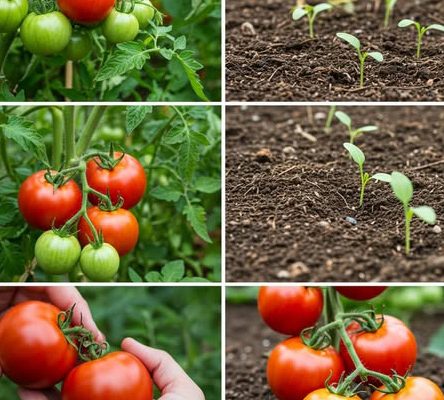This guide will show you how to grow tomatoes the easy, eco-friendly way—by recycling what’s already in your kitchen. Whether you’re a beginner or have struggled with tomato plants in the past, these tips will help you succeed with less effort and more satisfaction.
Why Tomatoes Love Kitchen Scraps
Tomato plants are heavy feeders. They require rich, well-balanced soil full of nutrients to thrive. Fortunately, many of the nutrients tomatoes need—like calcium, potassium, nitrogen, and phosphorus—can be found in common kitchen waste.
Incorporating these scraps into your planting and care routine not only saves money, but also reduces food waste and enriches the soil naturally.
Start with Tomato Slices or Seeds
If you’ve ever sliced a tomato and noticed all those tiny seeds inside, you already have the beginning of your next tomato plant.
Method 1: Using Tomato Slices
-
-
Choose an overripe or soft tomato.
-
Slice it into thin rounds.
-
Place the slices on top of a pot filled with potting soil.
-
-
Cover lightly with more soil (about ¼ inch).
-
Water gently and keep in a warm, sunny spot.
In 7–14 days, the seeds inside the slices will germinate and send up tiny green shoots. Once the seedlings are 2–3 inches tall, thin them out, keeping the strongest ones.
Method 2: Drying and Saving Seeds
Let seeds from a ripe tomato dry on a paper towel for a few days. Once dry, you can store them or plant them directly into soil.
Enrich Soil with Kitchen Scraps
Before planting your tomato seedlings, add a few nutrient-boosting kitchen scraps directly into the hole or container. These act as slow-release fertilizers that nourish the plant over time.
Here are some scraps that work wonders:
-
-
Crushed Eggshells: Packed with calcium, they help prevent blossom-end rot—a common tomato issue.
-
Banana Peels: Rich in potassium and phosphorus, banana peels boost flower and fruit production.
-
-
-
Used Coffee Grounds: A source of nitrogen, they also improve soil texture and attract beneficial earthworms.
-
Chopped Onion Peels or Garlic Skins: These add micronutrients and can deter certain pests.
-
Vegetable Scraps: Blend them into a compost slurry and mix with soil for a nutrient-rich base.
-
How to Use:
-
-
Dig a hole where you’ll plant your tomato.
-
-
-
Add a layer of kitchen scraps.
-
Cover with a bit of soil to prevent root burn.
-
Plant your seedling on top.
-
Container Gardening with Tomatoes
If you don’t have a garden, tomatoes still thrive in containers on balconies, windowsills, or patios.
Container Tips:
-
-
Use pots at least 12 inches deep.
-
Ensure good drainage holes.
-
-
Choose compact or determinate varieties like Patio Princess, Bush Early Girl, or Tiny Tim.
-
Use high-quality potting mix mixed with your chosen kitchen scraps.
Support your plant with a tomato cage, bamboo stake, or trellis as it grows to prevent breakage and improve airflow.
Watering and Feeding the Natural Way
Tomatoes need consistent moisture but don’t like soggy roots. Water when the top inch of soil feels dry. Morning is the best time to water to avoid mildew and fungal diseases.
For fertilizing:
-
-
Blend banana peel water: Soak chopped peels in water for 2–3 days, then water your plant with the enriched liquid.
-
-
Use eggshell tea: Soak crushed eggshells in water for a day and use to water your plant weekly.
These gentle, natural options provide essential nutrients without overwhelming the plant.
Mulching and Maintenance
Mulch helps retain soil moisture, reduce temperature swings, and suppress weeds. Shredded newspaper, dried leaves, or grass clippings from the kitchen compost bin all make great mulch options.
Remove yellowing leaves and any lower leaves that touch the soil to prevent disease. If you notice any pests, a homemade spray of garlic water or diluted neem oil can be an effective natural deterrent.
Harvesting Your Homegrown Tomatoes
Depending on the variety, tomatoes are typically ready for harvest 60–85 days after planting. Pick them when they are fully colored and slightly soft to the touch.
The more you harvest, the more the plant will produce. With healthy roots and nutrient-rich support from your kitchen scraps, you can expect a generous yield—even in a small space.
Final Thoughts
Growing tomatoes doesn’t have to be expensive or complicated. By using what you already have in your kitchen—like tomato slices, eggshells, banana peels, and coffee grounds—you can nourish vibrant plants and enjoy homegrown tomatoes bursting with flavor.
No garden? No problem. With a pot, a bit of sunlight, and a handful of scraps, you’ll be amazed by how easily tomatoes can thrive under your care. It’s a sustainable, rewarding way to garden—even in the heart of the city.
